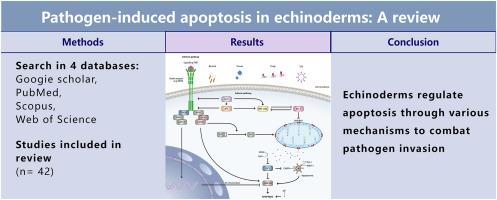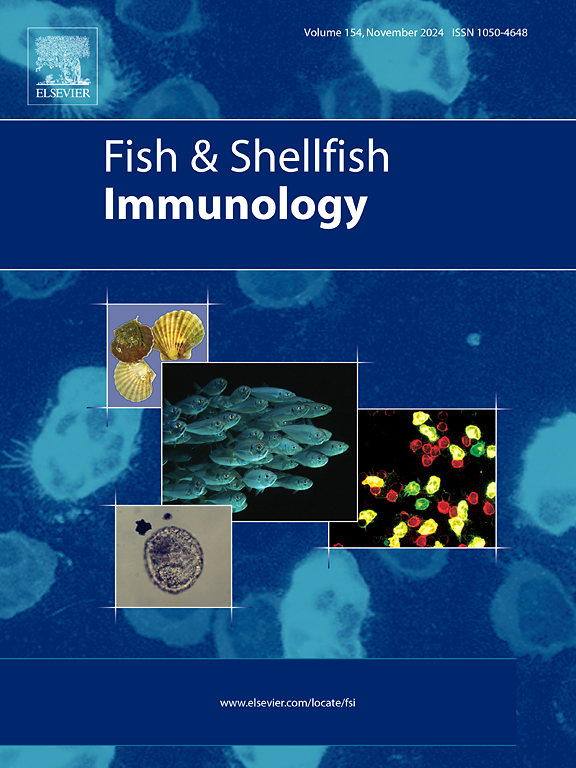Pathogen-induced apoptosis in echinoderms: A review
IF 4.1
2区 农林科学
Q1 FISHERIES
引用次数: 0
Abstract
Echinoderms possess unique biological traits that make them valuable models in immunology, regeneration, and developmental biology studies. As a class rich in active substances with significant nutritional and medicinal value, echinoderms face threats from marine pathogens, including bacteria, viruses, fungi, protozoa, and parasites, which have caused substantial economic losses in echinoderm aquaculture. Echinoderms counteract pathogen invasion through innate immunity and programmed cell death, in particular, with apoptosis being essential for eliminating infected or damaged cells and maintaining homeostasis in many echinoderm cell types. Despite the importance of this process, there is a lack of comprehensive and updated reviews on this topic. This review underscores that echinoderm apoptotic pathways exhibit a complexity comparable to that of vertebrates, featuring proteins with unique domains that may indicate the presence of novel signaling mechanisms. We synthesize current knowledge on how echinoderms utilize diverse transcriptional and post-transcriptional mechanisms to regulate apoptosis in response to pathogen infections and explore how pathogens have evolved strategies to manipulate echinoderm apoptosis, either by inhibiting it to create survival niches or by inducing excessive apoptosis to weaken the host. By elucidating the primary apoptotic pathways in echinoderms and the host-pathogen interactions that modulate these pathways, this review aims to reveal new mechanisms of apoptosis in animal immune defense and provide insights into the evolutionary arms race between hosts and pathogens.

棘皮动物中病原体诱导的细胞凋亡:综述。
棘皮动物具有独特的生物特征,是免疫学、再生和发育生物学研究的宝贵模型。棘皮动物含有丰富的活性物质,具有重要的营养和药用价值,但棘皮动物也面临着来自细菌、病毒、真菌、原生动物和寄生虫等海洋病原体的威胁,给棘皮动物养殖业造成了巨大的经济损失。棘皮动物通过先天性免疫和程序性细胞死亡来抵御病原体的入侵,特别是细胞凋亡对于消除受感染或受损的细胞以及维持棘皮动物许多细胞类型的平衡至关重要。尽管这一过程非常重要,但目前还缺乏有关这一主题的全面、最新综述。这篇综述强调棘皮动物的凋亡途径表现出与脊椎动物相当的复杂性,其特点是蛋白质具有独特的结构域,这可能表明存在新的信号转导机制。我们综述了棘皮动物如何利用多种转录和转录后机制来调控细胞凋亡以应对病原体感染的现有知识,并探讨了病原体是如何进化出操纵棘皮动物细胞凋亡的策略的,要么抑制细胞凋亡以创造生存壁龛,要么诱导过度细胞凋亡以削弱宿主。通过阐明棘皮动物的主要凋亡途径以及调节这些途径的宿主与病原体之间的相互作用,本综述旨在揭示动物免疫防御中的凋亡新机制,并为宿主与病原体之间的进化军备竞赛提供见解。
本文章由计算机程序翻译,如有差异,请以英文原文为准。
求助全文
约1分钟内获得全文
求助全文
来源期刊

Fish & shellfish immunology
农林科学-海洋与淡水生物学
CiteScore
7.50
自引率
19.10%
发文量
750
审稿时长
68 days
期刊介绍:
Fish and Shellfish Immunology rapidly publishes high-quality, peer-refereed contributions in the expanding fields of fish and shellfish immunology. It presents studies on the basic mechanisms of both the specific and non-specific defense systems, the cells, tissues, and humoral factors involved, their dependence on environmental and intrinsic factors, response to pathogens, response to vaccination, and applied studies on the development of specific vaccines for use in the aquaculture industry.
 求助内容:
求助内容: 应助结果提醒方式:
应助结果提醒方式:


